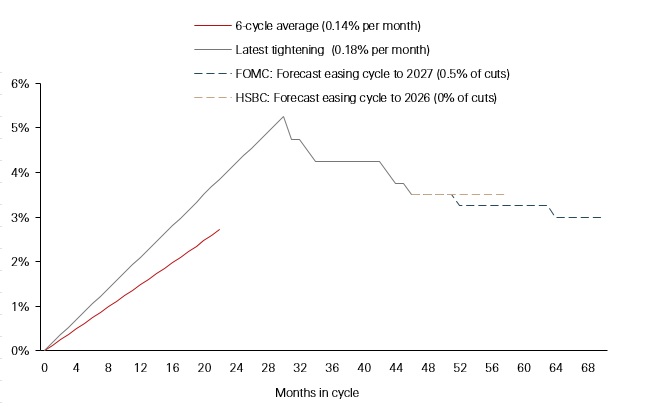
12 December 2025
Jonathan Sparks
Chief Investment Officer, UK, HSBC Private Bank and Premier Wealth
The Federal Reserve’s December meeting delivered its third consecutive rate cut, lowering the federal funds target range to 3.50-3.75%. With the sting taken out of policy rates, Chair Powell signaled that that the Fed would take a more balanced, data-dependent view from here. While the 0.25% cut itself was widely expected, the meeting revealed a more nuanced and, in some respects, divided policy backdrop. The 9-3 vote underscored growing differences within the committee, with some members preferring to hold rates steady and others arguing for a larger cut. Yet Powell’s message was consistent that policy is now within a plausible range of the “neutral rate”, giving the Fed room to pause, observe, and respond as the economy evolves.
What stood out most was the Fed’s deliberate shift in communication. The December statement removed language suggesting unemployment had “remained low” and acknowledged rising downside risks to employment. At the same time, it reinstated language around “the extent and timing of additional adjustments,” a phrase historically used when the Fed wants to avoid committing to a preset easing path. Powell reinforced this point in the press conference, emphasising that policy is “well positioned” to wait for clearer signals from inflation and labour market data. In short, this was not a promise of continued rate cuts, but an assertion of flexibility.
The US continues to stand out for its economic resilience. Growth expectations for 2026 were upgraded meaningfully, with real GDP now seen at 2.3%, reflecting resilience in domestic demand and a rebound from the temporary drag caused by the recent government shutdown. This jars with today’s October GDP release from the UK, which showed a 0.1% contraction. Although Powell was careful to note that part of this upgrade is mechanical rather than structural, there is a clear daylight between the US and the UK on growth. When the BoE meets next week, we expect them to cut rates and diverge from the Fed messaging that they are in a happy place unless the data tells them otherwise. Whereas the BoE are more likely to signal that quarterly pace of cuts will continue well into 2026, which would get them closer to a “neutral rate” that sits around 0.5% below the US.
Labour market dynamics remain central to the policy debate and this will likely guide the Fed in the coming months. The Fed acknowledged evidence of cooling, driven by slower immigration, easing labour demand, and softer job availability. He framed recent labour market softness as cyclical rather than structural, pushing back against concerns that AI-driven disruption is already feeding into layoffs. Productivity is rising, but the disruptive effects of generative AI, in Powell’s words, are “not showing up in layoffs yet”.
Markets, however, are leaning more aggressively toward easing. Futures currently price around two rate cuts in 2026, while the Fed’s median projection implies just one cut next year and another in 2027. This gap highlights a key tension heading into 2026: investors appear to expect a faster slowdown than policymakers currently see. We expect this reflects a cohort of investors pricing in a more dovish new Fed Chair influencing policy. We don’t doubt that next that there could be a more divided Fed next year, but we also see several hurdles to a much more dovish Fed. For now, the Fed remains comfortable holding rates steady, allowing growth, earnings, and inflation trends to do the heavy lifting.
From an investment perspective, we think the current mix of lower policy rates, an end to quantitative tightening and still-resilient earnings growth creates a more supportive backdrop for risk assets. Easier financial conditions should continue to flow through to corporate profitability, helping keep valuations anchored even as growth moderates. We believe technology and AI-linked sectors remain key beneficiaries, not just from falling real yields but also from the ongoing productivity and investment cycle that Powell himself described as structural rather than speculative. Beyond AI, we think Industrials and Utilities stand to benefit from the re-industrialisation trend, infrastructure spending and improving macro visibility, while Financials can provide diversification within equity portfolios given their sensitivity to growth rather than falling rates alone.
In fixed income, we believe the Fed’s focus on inflation normalisation and its willingness to pause rather than rush further cuts supports a constructive environment for US government bonds, particularly at medium durations. At the same time, we remain cautious on high yield, where spreads leave limited room for error should growth or earnings disappoint. On currencies, we think the US dollar could see near-term downside as markets continue to price additional easing, but a pause in cuts, resilient US activity and renewed emphasis on Fed independence should help limit sustained weakness. Overall, we see a data-dependent Fed, moderating inflation and resilient earnings as a favourable macro mix for diversified multi-asset portfolios, with continued opportunities in quality equities, selective credit and long-term productivity-driven themes

Source: Bloomberg

We’re not trying to sell you any products or services, we’re just sharing information. This information isn’t tailored for you. It’s important you consider a range of factors when making investment decisions, and if you need help, speak to a financial adviser.
As with all investments, historical data shouldn’t be taken as an indication of future performance. We can’t be held responsible for any financial decisions you make because of this information. Investing comes with risks, and there’s a chance you might not get back as much as you put in.
This document provides you with information about markets or economic events. We use publicly available information, which we believe is reliable but we haven’t verified the information so we can’t guarantee its accuracy.
This document belongs to HSBC. You shouldn’t copy, store or share any information in it unless you have written permission from us.
We’ll never share this document in a country where it’s illegal. This document is prepared by, or on behalf of, HSBC UK Bank Plc, which is owned by HSBC Holdings plc. HSBC’s corporate address is 1 Centenary Square, Birmingham BI IHQ United Kingdom. HSBC UK is governed by the laws of England and Wales. We’re authorised by the Prudential Regulation Authority (PRA) and regulated by the Financial Conduct Authority (FCA) and the PRA. Our firm reference number is 765112 and our company registration number is 9928412.